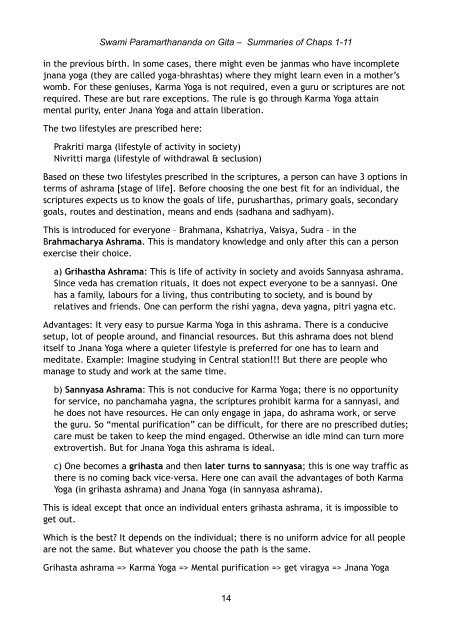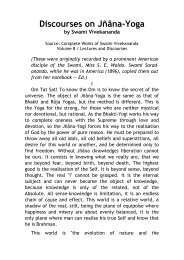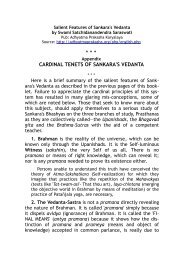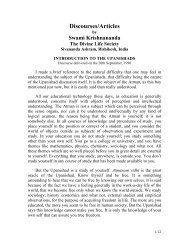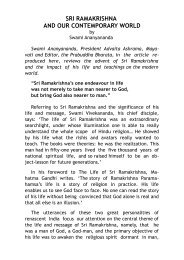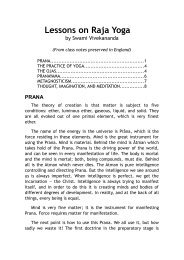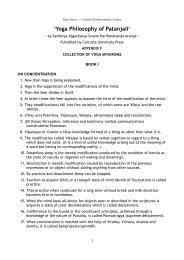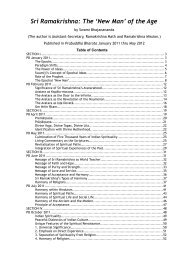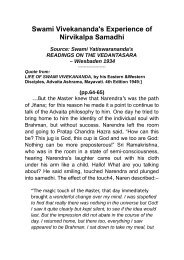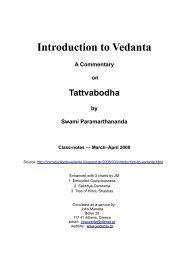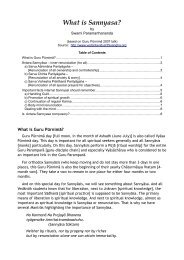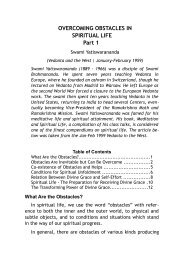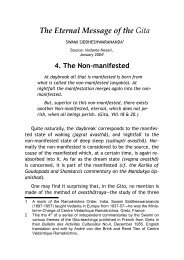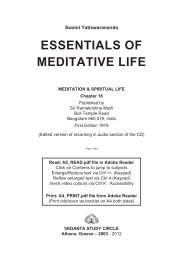Gita Summaries: Chapters 1-11 - Vedanta
Gita Summaries: Chapters 1-11 - Vedanta
Gita Summaries: Chapters 1-11 - Vedanta
Create successful ePaper yourself
Turn your PDF publications into a flip-book with our unique Google optimized e-Paper software.
Swami Paramarthananda on <strong>Gita</strong> – <strong>Summaries</strong> of Chaps 1-<strong>11</strong><br />
in the previous birth. In some cases, there might even be janmas who have incomplete<br />
jnana yoga (they are called yoga-bhrashtas) where they might learn even in a mother’s<br />
womb. For these geniuses, Karma Yoga is not required, even a guru or scriptures are not<br />
required. These are but rare exceptions. The rule is go through Karma Yoga attain<br />
mental purity, enter Jnana Yoga and attain liberation.<br />
The two lifestyles are prescribed here:<br />
Prakriti marga (lifestyle of activity in society)<br />
Nivritti marga (lifestyle of withdrawal & seclusion)<br />
Based on these two lifestyles prescribed in the scriptures, a person can have 3 options in<br />
terms of ashrama [stage of life]. Before choosing the one best fit for an individual, the<br />
scriptures expects us to know the goals of life, purusharthas, primary goals, secondary<br />
goals, routes and destination, means and ends (sadhana and sadhyam).<br />
This is introduced for everyone – Brahmana, Kshatriya, Vaisya, Sudra – in the<br />
Brahmacharya Ashrama. This is mandatory knowledge and only after this can a person<br />
exercise their choice.<br />
a) Grihastha Ashrama: This is life of activity in society and avoids Sannyasa ashrama.<br />
Since veda has cremation rituals, it does not expect everyone to be a sannyasi. One<br />
has a family, labours for a living, thus contributing to society, and is bound by<br />
relatives and friends. One can perform the rishi yagna, deva yagna, pitri yagna etc.<br />
Advantages: It very easy to pursue Karma Yoga in this ashrama. There is a conducive<br />
setup, lot of people around, and financial resources. But this ashrama does not blend<br />
itself to Jnana Yoga where a quieter lifestyle is preferred for one has to learn and<br />
meditate. Example: Imagine studying in Central station!!! But there are people who<br />
manage to study and work at the same time.<br />
b) Sannyasa Ashrama: This is not conducive for Karma Yoga; there is no opportunity<br />
for service, no panchamaha yagna, the scriptures prohibit karma for a sannyasi, and<br />
he does not have resources. He can only engage in japa, do ashrama work, or serve<br />
the guru. So “mental purification” can be difficult, for there are no prescribed duties;<br />
care must be taken to keep the mind engaged. Otherwise an idle mind can turn more<br />
extrovertish. But for Jnana Yoga this ashrama is ideal.<br />
c) One becomes a grihasta and then later turns to sannyasa; this is one way traffic as<br />
there is no coming back vice-versa. Here one can avail the advantages of both Karma<br />
Yoga (in grihasta ashrama) and Jnana Yoga (in sannyasa ashrama).<br />
This is ideal except that once an individual enters grihasta ashrama, it is impossible to<br />
get out.<br />
Which is the best It depends on the individual; there is no uniform advice for all people<br />
are not the same. But whatever you choose the path is the same.<br />
Grihasta ashrama => Karma Yoga => Mental purification => get viragya => Jnana Yoga<br />
14


